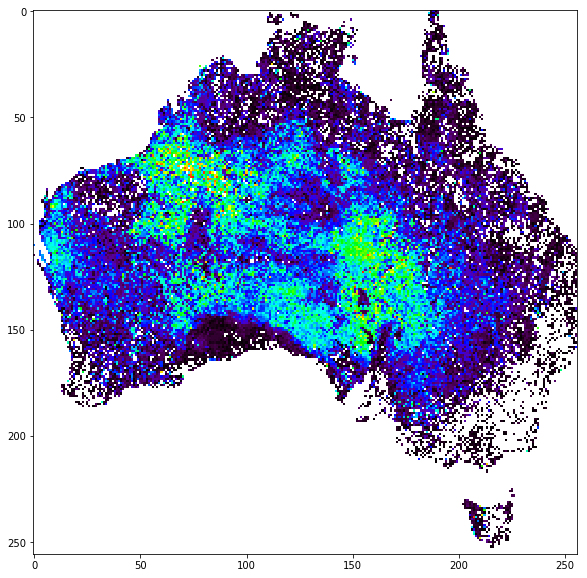Requesting ASTER map images through NCI’s GSKY Data Server¶
NCI’s GSKY Data Server supports the Open Geospatial Consortium (OGC) Web Map Service (WMS), which is a standard protocol for serving geospatial data as images (e.g., PNG).
Constructing WMS Requests
To request a spatial subset of data through GSKY using WMS, a GetMap URL defining the subset has to be constructed. This URL can be used within a web browser to communicate to the GSKY Data Server, which will return the requested map image of the subset.
http://gsky.nci.org.au/ows/aster? service = WMS &version = 1.3.0 &request = GetMap &layers = value &crs = value &styles =value &format =value &bbox =value &width =value &height =value &colourscalerange =value &transparent =value &time =value
GetMap parameters:
| Parameter | Required/Optional | Input |
|---|---|---|
| service | Required | WMS |
| version | Required | 1.1.1**, 1.3.0 (default) |
| request | Required | GetMap |
| layers | Required | <variable> |
| crs | Required | <crs_value> |
| styles | Required | <style_name> |
| format | Required | image/png, image/png;mode=32bit, image/gif, image/jpeg |
| bbox | Required | <ymin,xmin,ymax,xmax> |
| width | Required | Image width in pixels |
| height | Required | Image height in pixels |
| colorscalerange | Optional | <min,max> |
| transparent | Optional | True, False |
| time | Optional | <time_value> |
**Syntax differences for v1.1.1 GetMap requests: - Use srs in place of crs - The order of bbox values is: <xmin,ymin,xmax,ymax>
WMS GetCapabilities Request
In order to contruct the GetMap URL, a GetCapabilities request can be made to the server. This requests returns an xml describing the available WMS parameters (metadata, services, and data) made available by NCI’s GSKY server.
GetCapabilities example:
GetMap Request
Using the information returned from a GetCapabilities request, a GetMap URL can be constructed and then entered into the address bar of any web browser.
Example GetMap request:
Using GSKY’s WMS in Python¶
Many tools are available to perform the above steps less manually. In particular, Python’s OWSLib library can be used with GSKY’s WMS.
The following libraries will need to be imported for the below example.
[1]:
from owslib.wms import WebMapService
from PIL import Image
import matplotlib.pyplot as plt
%matplotlib inline
To start, we will need the base GSKY server URL:
[2]:
gsky_url = 'http://gsky.nci.org.au/ows/aster'
Now using OWSLib, you can begin by inspecting the service metadata:
[3]:
wms = WebMapService(gsky_url, version='1.3.0')
Find out the available data layers that can be requested:
[4]:
for layer in list(wms.contents):
print("Layer Name:", wms[layer].name)
print("Title:", wms[layer].title, '\n')
Layer Name: AlOH_Group_Composition
Title: ASTER Map AlOH Group Composition
Layer Name: AlOH_Group_Content
Title: ASTER Map AlOH Group Content
Layer Name: FeOH_Group_Content
Title: ASTER Map FeOH Group Content
Layer Name: Ferric_Oxide_Composition
Title: ASTER Map Ferric Oxide Composition
Layer Name: Ferric_Oxide_Content
Title: ASTER Map Ferric Oxide Content
Layer Name: Ferrous_Iron_in_MgOH
Title: ASTER Map Ferrous Iron Content in MgOH/carbonate
Layer Name: Ferrous_Iron_Index
Title: ASTER Map Ferrous Iron Index
Layer Name: Green_Vegetation_Content
Title: ASTER Map Green Vegetation Content
Layer Name: Kaolin_Group_Index
Title: ASTER Map Kaolin Group Index
Layer Name: MgOH_Group_Composition
Title: ASTER Map MgOH Group Composition
Layer Name: MgOH_Group_Content
Title: ASTER Map MgOH Group Content
Layer Name: Opaque_Index
Title: ASTER Map Opaque Index
Layer Name: Quartz_Index
Title: ASTER Map TIR Quartz Index
Layer Name: Silica_Index
Title: ASTER Map TIR Silica Index
We can also view metadata that is available about a selected layer. For example, you can view the abstract associated with that data layer.
[5]:
layer = "Silica_Index"
[6]:
print(wms[layer].abstract)
1. Band ratio: B13/B10 Blue is low silica content Red is high silica content (potentially includes Si-rich minerals, such as quartz, feldspars, Al-clays)
Geoscience Applications: Broadly equates to the silica content though the intensity (depth) of this reststrahlen feature is also affected by particle size less than 250 micron. Useful product for mapping: (1) colluvial/alluvial materials; (2) silica-rich (quartz) sediments (e.g. quartzites); (3) silification and silcretes; and (4) quartz veins. Use in combination with quartz index, which is often correlated with the Silica index.
NCI Data Catalogue: http://dx.doi.org/10.25914/5f224f299e246
Or view the CRS options, bounding box, and time positions available (these details will be needed to construct the GetMap request).
[7]:
print("CRS Options: ")
crs = wms[layer].crsOptions
print('\t', crs, '\n')
print("Bounding Box: ")
bbox = wms[layer].boundingBox
print('\t', bbox, '\n')
print("Time Positions: ")
time = wms[layer].timepositions
print('\t', time[:10], '\n')
CRS Options:
['EPSG:3857', 'EPSG:4326']
Bounding Box:
(-180.0, -90.0, 180.0, 90.0, 'EPSG:4326')
Time Positions:
['2012-06-01T00:00:00.000Z']
Now let’s use the information above to construct and make the GetMap request
We’ll need to define a bounding box for our request:
[8]:
subset_bbox = (113, -44, 153, -11)
OWSLib’s library can now be used to make the GetMap request:
[9]:
output = wms.getmap(layers=[layer],
srs='EPSG:4326',
bbox=(subset_bbox[0], subset_bbox[1], subset_bbox[2], subset_bbox[3]),
size=(256, 256),
format='image/png',
time=time[0]
)
To view the above constructed URL:
[10]:
print(output.geturl())
http://gsky.nci.org.au/ows/aster?SERVICE=WMS&service=WMS&version=1.3.0&request=GetMap&layers=Silica_Index&styles=&width=256&height=256&crs=EPSG%3A4326&bbox=-44%2C113%2C-11%2C153&format=image%2Fpng&transparent=FALSE&bgcolor=0xFFFFFF&exceptions=XML&time=2012-06-01T00%3A00%3A00.000Z
Lastly, we need to write the GetMap result to a file:
[11]:
pngfile = './gsky_getMap.png'
with open(pngfile, 'wb') as out:
out.write(output.read())
And if we’d like to confirm the result:
[12]:
im = Image.open(pngfile)
plt.figure(figsize=(10, 10))
plt.imshow(im)
[12]:
<matplotlib.image.AxesImage at 0x11b3f5b00>

For more information on the OGC WMS standard specifications and the Python OWSLib package: http://www.opengeospatial.org/standards/wms